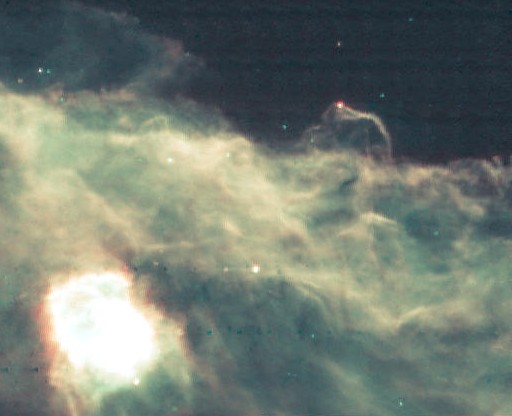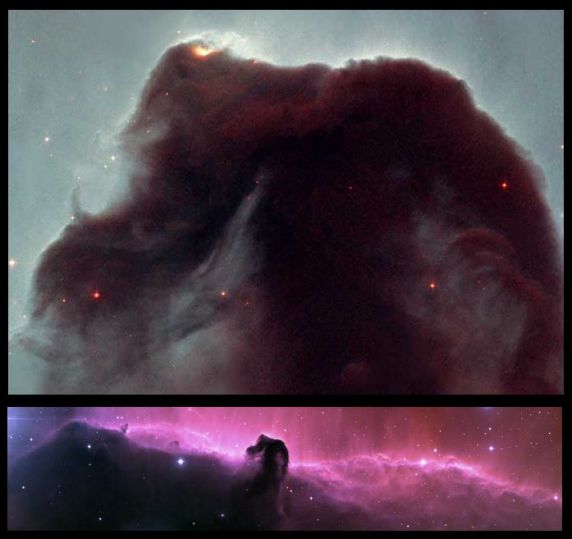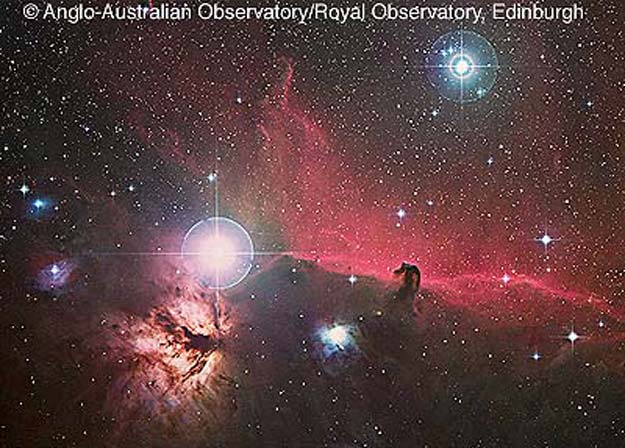Astronomy Picture of the Day
Discover the cosmos! Each day a different image or photograph of our fascinating universe is featured, along with a brief explanation written by a professional astronomer.
Posted on 07/12/2003 10:50:33 PM PDT by petuniasevan
Discover the cosmos! Each day a different image or photograph of our fascinating universe is featured, along with a brief explanation written by a professional astronomer.
Explanation: One of the most identifiable nebulae in the sky, the Horsehead Nebula in Orion, is part of a large, dark, molecular cloud. Also known as Barnard 33, the unusual shape was first discovered on a photographic plate in the late 1800s. The red glow originates from hydrogen gas predominantly behind the nebula, ionized by the nearby bright star Sigma Orionis. The darkness of the Horsehead is caused mostly by thick dust, although the lower part of the Horsehead's neck casts a shadow to the left. Streams of gas leaving the nebula are funneled by a strong magnetic field. Bright spots in the Horsehead Nebula's base are young stars just in the process of forming. Light takes about 1500 years to reach us from the Horsehead Nebula. The above image was taken with the 0.9-meter telescope at Kitt Peak National Observatory.
About this image
This color picture was made by combining several exposures taken on the night of December 28th 1994 (UT of observation 29/12/94 around 04:00) with a 2048x2048 CCD detector at the 0.9m telescope of the Kitt Peak National Observatory. Observing conditions were not ideal throughout, and so only a select few of the original observations were used. The final tally used five frames in the B (blue) filter for a total of 22 minutes, three frames with the V (green) filter, 15 minutes, and two with the R (red), total 10 minutes. Each frame was carefully cleaned, a particularly difficult task for the blue filter due to internal reflection problems in the telescope, and then aligned and combined by computer to create this (approximately) true color picture. The pixel size on the sky is 0.68 arc seconds; after combination, the final size is 1480x1366, or about 17x15 arc minutes.
Orientation of image: north to the left, east down.
I've mentioned this before, but some of you may not know: the Horsehead Nebula is an EXTREMELY difficult object visually. I used to own a 10" equatorial reflector telescope. I had no luck sighting the Horsehead, even with dark, dry northern California skies. Now I live in Wisconsin and am surrounded by light pollution and either hazy humidity, clouds, or arctic temps. Oh well.
Horsehead and environs in infrared.

Compare that to the Hubble image of the top of the Horsehead, and the wider field version of today's APOD:

Here's a "long shot" view of the Horsehead Nebula and surrounding area. The overexposed stellar images are Zeta Orionis (Alnitak) at left and Sigma Orionis at upper right.



.

Yes, it's under construction. I especially need your questions for the FAQ page. Also if you have a term for the glossary page, let me know. FReepmail me. Thanks for visiting the new site, and thanks to Fiddlstix for hosting it.
Happy to help J
(Have some coffee and donuts...... :)
Good Morning Everybody.
| You Know The Drill Click the Pics J |
You asked for it. Why are so many objects of astronomical interest in the southern hemisphere while the northern hemisphere is boring?
Disclaimer: Opinions posted on Free Republic are those of the individual posters and do not necessarily represent the opinion of Free Republic or its management. All materials posted herein are protected by copyright law and the exemption for fair use of copyrighted works.